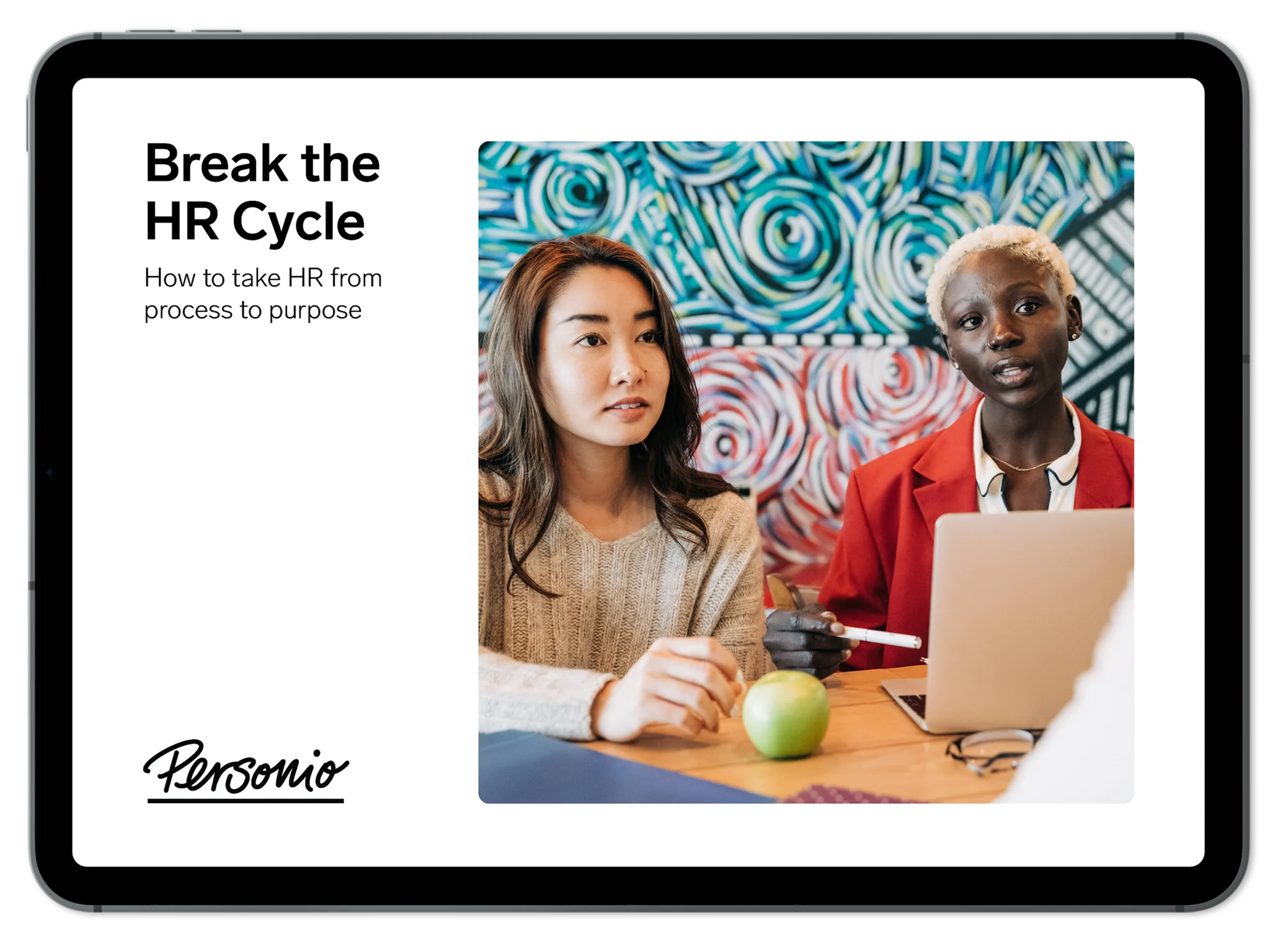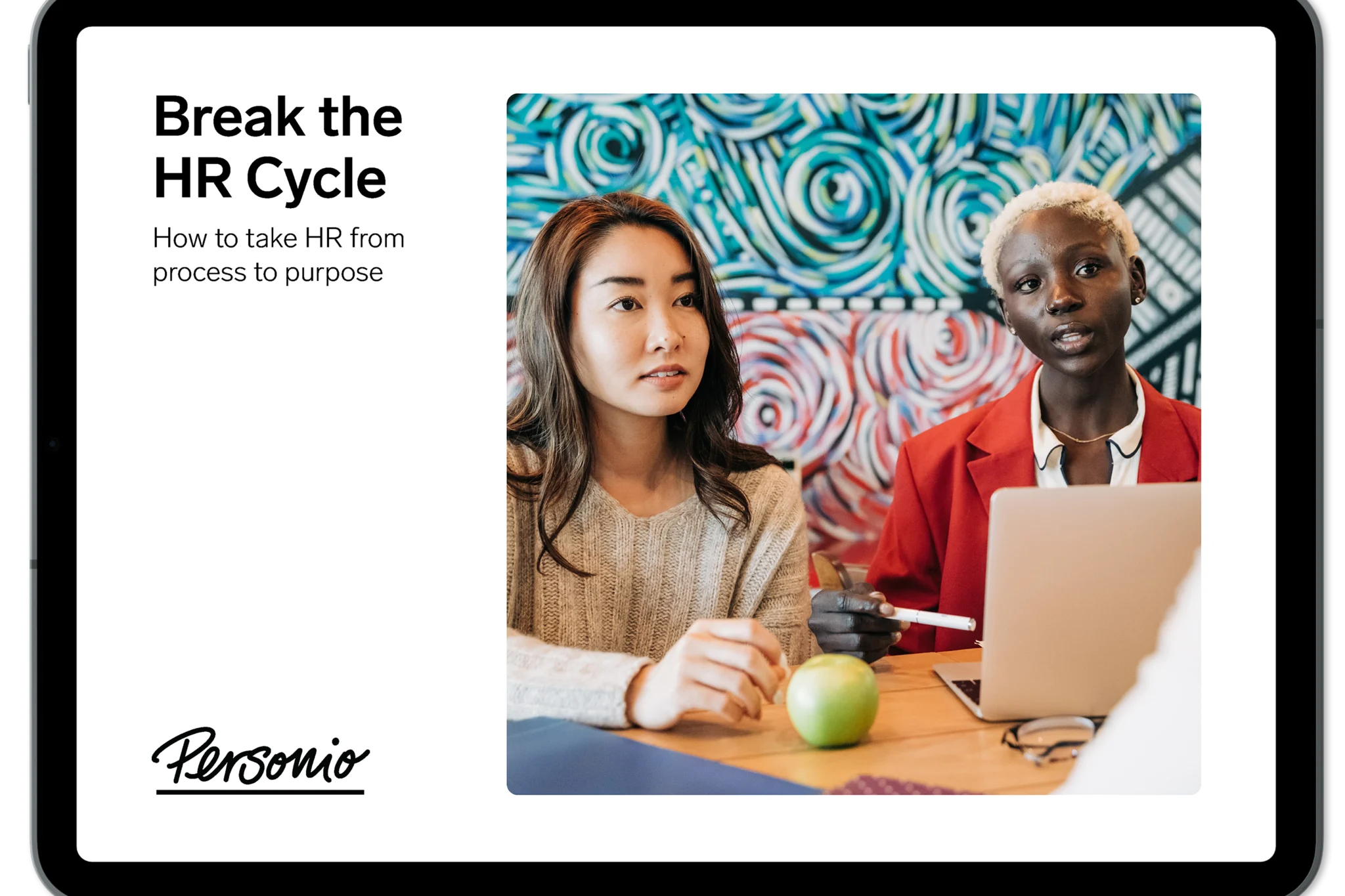
Are you stuck in an endless loop of time-consuming tasks?
Learn how to take HR from process to purpose.
Download NowThe Ulrich Model: What It Is And Why It Matters

In 1996, influential HR theorist Dave Ulrich published a book on HR Management called "Human Resource Champions." In it, he documented a process that has since become known as the Ulrich model.
In this article, we offer an overview of the Ulrich model, how it works, and discussions around how it has evolved since its inception.
Pave the way for strategic HR work to shine. Discover Personio today.What Is The Ulrich Model?
The Ulrich model is thought of as a way of dividing HR organisations into separate functions. There are four functions, each with a name or persona. As a result, each person operating within one of these roles becomes a specialist.
The four roles outlined include:
Strategic Partner
Change Agent
Administrative Expert
Employee Champion
How Does The Ulrich Model Work?
When the model was first crafted, HR's role was considered purely administrative. Today, that has changed, but the Ulrich model played a key role in turning that perspective on its head!
In fact, the very model itself was designed to shift the paradigm and the role that HR played from administrative to strategic.
Essentially, separating the roles of HR into these four categories allowed HR employees to specialise in a particular area of HR, and allowed businesses to focus on delivering higher-value HR as a whole.
Does The Ulrich Model Have Disadvantages?
The Ulrich model was revolutionary in that it helped redesign the overall perspective of HR departments. It did this by suggesting and facilitating a shift from administrative to strategic partners.
While it may design them as such, the Ulrich Model doesn’t necessarily allow HR leaders to become strategy experts, or to use their strategic influence to improve the nature of work for employees.
Why? Because, fundamentally, HR leaders aren’t the only ones responsible for transforming HR. This cannot happen without the involvement of the CEO, and other senior leaders.
This means that the typical issues that plague HR teams, busy work, administrative tasks piling up, and either not enough or too many technological solutions, still become an issue.
Not enough organisations have been able to use the Ulrich model, or use it efficiently.
But, Is The Ulrich Model Effective?
In a 2017 review of the evolution of the HR profession published in HR Magazine, Ulrich himself stated that it is important for the HR profession “to recognise, and appreciate that progress that has been made… [and that] HR professionals have become more competent over the past 30 years.”
In fact, Ulrich has also argued that the model was never designed to resolve all HR issues. However, in 2014 he defended the model, saying that it has evolved – and so has HR thinking, but that the fundamental question of how HR can add value to a business has not changed. Nor should it.
His article on the evolution of the HR business partner, published by Strategic Leadership, summarises his thinking on how the Ulrich model has evolved over time.
Covering 13 key areas, here’s what he says:
HR is no longer about efficiency, it’s about strategic, outside-in HR.
HR is no longer just about HR, it’s about the changes facing the business in a VUCA world.
HR doesn’t just serve employers – it serves customers, investors, and the community, too.
HR still has to serve talent – but this has gone beyond productivity, and employee experience and now also embraces competence, commitment, and contribution.
HR must continue to support a competitive organisation, but this has evolved to include morphology, alignment, capability, and ecosystem capability.
HR knows that leadership is no longer just about the individual leader – it also includes the need to embrace a leadership brand, and the ability to do, and embrace many more skills.
HR strategy must answer the questions of who HR is, what they deliver, and why they exist.
HR organisational structure must separate transactional work from strategic work, while aligning with the business strategy, and embracing a matrix structure.
HR practices today should be integrated, not isolated, aligned with both internal, and external customer-facing strategies, innovative, and enhanced with easy-to-use HR solutions.
HR competencies have evolved. HR leaders must now be credible activists, strategic positioners, and paradox navigators.
HR technology must help create business strategy, and apply digital information to do HR better, to do better HR, to access ideas, and to connect people.
HR analytics has evolved to go beyond a scorecard of HR activities, to create insights, interventions for specific actions, and impact in terms of business results.
HR work style is about assigning roles, and accountabilities, but it’s arguably more important to build relationships by sharing a common purpose, respecting differences, showing empathy, sharing experiences, and growing together.
Holistic HR software, designed to help HR evolve. Find out more here.
What Kinds Of Organisations Should Use The Ulrich Model?
While the Ulrich model is more often implemented by larger organisations, the fundamentals (particularly the way they have evolved) can be used by companies of all sizes: if used appropriately.
For example, the concept of outsourcing busy work to tools that are more suited to the purpose, such as an HR system or software, allows HR leaders to make core HR as simple as possible so that managers can become true strategic partners, transforming HR departments.
When HR uses the appropriate tools, critical information is digitised. This means productivity can be increased, and costs can be lowered because more efficient processes can be used.
That allows HR and other business leaders to analyze data more effectively. HR can then add value to the organisation directly by providing the relevant information to inform strategic decision-making.
Lastly, the right solutions allow organisations to optimise their HR performance and unleash the workforce’s true potential by improving HR, consistently and diligently, for the good of the company.
As a result, HR can become a true strategic partner to the organisation.
What Does A Strategic Partner In HR Do?
Research by Personio revealed that 80% of HR managers want to be more involved in strategic decision-making. But HR can only work strategically if the fundamentals are in place.
In order to gain a seat at the table, HR strategy must become a corporate process.
As we explain in our blog post on What Strategic HR Needs to Achieve Long-Term Success, HR leaders need to step away from an administrative role. So, sadly, although much has changed since the Ulrich model was introduced, some things remain the same.
In order for HR leaders to initiate change projects, and drive them forwards, to remain active in their role as consultants, and coaches, and to develop important HR-related initiatives, they need additional skills and, most importantly, the resources to allow the time for strategic thinking.
Then, and only then, can HR leaders become truly strategic partners.
How Can HR Become A Strategic Partner?
Geraldine MacCarthy, the Chief Revenue Officer at Personio argues that it is possible to turn strategic work into your business’s competitive edge in our HR Lexicon article by the same name. It’s not easy, but it’s possible.
HR can become a strategic partner by:
Spending less time involved in manual processes, and more time working on HR strategy
Using technology to avoid attention fragmentation: Making work more seamless and, therefore, more productive.
Building towards something bigger – by using the right tools to allow people to do their best work without annoying, unproductive tasks get in the way.
The only question remains: What are you going to do to turn the dream of a strategic HR team, as envisioned by Ulrich all those years ago, into reality?
When you’re ready to take the first step – by removing the pain of HR data, and processes – talk to our Personio product experts. We can help.
